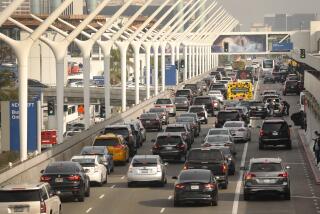LAX: Enlightened Change a Must
- Share via
It’s fair to ask how Southern California got into this aviation mess: spiraling air passenger and cargo growth, severe limits on some airport operations, and travelers coming from as far south as San Diego to reach the congested choke point that is Los Angeles International Airport. Now, the effort to prepare LAX for an even greater deluge of passengers and cargo promises to be one of the most spirited transportation battles of 2001.
Start with the restrictions on airport operations at three of the airports closest to LAX--Long Beach, Burbank-Glendale-Pasadena, and John Wayne in Orange County. When the government-controlled airline industry was deregulated in 1978, existing caps on airport operations were grandfathered in, but no new caps were allowed. This virtually assured that LAX would shoulder the brunt of any regional increase in passengers and cargo. The attempt to force a shift of some LAX operations to Palmdale in the early 1970s, which might have been possible in a regulated airline industry, foundered when the free market took over and focused primarily on LAX.
What must be remembered is that additional passengers and cargo will be coming to Southern California, period. The estimates range from 140 million to 157 million passengers per annum by 2015, up from 81 million in 1997. Air cargo to and from the region stands at 2.6 million tons annually and is expected to increase sharply.
LAX and its problems ought to be a center of discussion and leadership among the six major mayoral candidates: Xavier Becerra, Kathleen Connell, James K. Hahn, Steve Soboroff, Antonio Villaraigosa and Joel Wachs. So far, not one has stepped forward to champion an LAX upgrade. This should also be a major concern of the city attorney and the City Council, in which eight of the 15 seats are up for election in 2001.
In the coming weeks, Los Angeles World Airports, which operates LAX and the Ontario and Palmdale airports, will release its master plan recommendations on what to do about LAX, along with a draft of its environmental impact statement.
Opponents of improved facilities at LAX have already had a substantial impact. Gone from consideration is the addition of two runways. Airport officials recommend keeping the present four runways but reconfiguring them to prepare for 25 million more passengers annually, up from 64 million in 1999.
The plan also counts on reducing LAX’s share of regional traffic to 67%, down from 75% in 1997. The regional plan includes a hoped-for El Toro airport and expanded service at Palmdale, Ontario and three former Air Force bases--George, Norton and March.
Obviously, getting in and out of LAX is a huge problem that must be overcome. The recommended plan envisions, among other things, extending the Century Freeway to LAX’s ring road and extending the light rail Green Line to the airport. More work than the plan envisions will have to be done.
The airport is one of the region’s economic engines, generating tens of thousands of jobs and billions of dollars in revenue. As the focal point of Pacific Rim trade, LAX can ill afford to stand pat.
More to Read
Sign up for Essential California
The most important California stories and recommendations in your inbox every morning.
You may occasionally receive promotional content from the Los Angeles Times.










